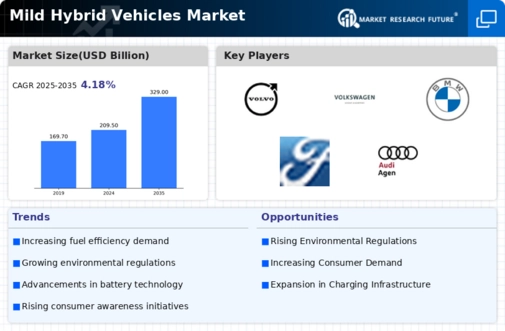Top Industry Leaders in the Mild Hybrid Vehicles Market
*Disclaimer: List of key companies in no particular order
Navigating the Rapidly Expanding Realm of Mild Hybrid Vehicles: A Comprehensive Exploration of the Competitive Landscape
The mild hybrid vehicle (MHEV) sector, once a niche market, is currently undergoing explosive growth, fueled by mounting environmental concerns, stricter emission regulations, and the growing demand for fuel efficiency. Positioned to secure a substantial share in the automotive industry, MHEVs find themselves in the midst of a highly competitive environment, where both established players and agile newcomers vie for supremacy.
Strategies of Key Players:
Prominent industry giants such as Toyota, Honda, and Volkswagen Group are leveraging their extensive resources and brand recognition to assertively expand their MHEV offerings. Toyota, a trailblazer in hybrid technology, is in the process of electrifying its entire vehicle lineup, with numerous popular models receiving the 48V MHEV treatment. Meanwhile, Volkswagen Group, in alignment with its ambitious push towards electric vehicles (EVs), is swiftly integrating MHEV technology across its diverse portfolio, with a specific focus on capturing a significant portion of the European market.
Players in the tier-2 category, including Ford and Suzuki, are adopting a more targeted approach by concentrating on specific regions and segments. Ford places a high priority on electrification in key markets such as China and Europe, while Suzuki capitalizes on its proficiency in smaller cars to develop fuel-efficient MHEVs tailored for cost-conscious consumers.
Newcomers to the scene, exemplified by BYD and Geely, are disrupting the market with innovative technologies and aggressive pricing strategies. BYD, recognized for its prowess in battery technology, is incorporating this expertise into its MHEV systems, promising superior performance and efficiency. On the other hand, Geely, with its vertically integrated supply chain, is driving down costs, making MHEVs more accessible to budget-conscious consumers.
Factors Influencing Market Share Analysis:
Analyzing market share dynamics in the dynamic MHEV landscape necessitates a departure from traditional metrics such as sales volume. Key considerations include:
Geographical Diversification: MHEV adoption varies significantly across regions, with Europe leading due to stringent emission regulations. Developing markets like China and India also show rapid growth. Establishing a robust presence in key growth markets confers a competitive advantage.
Segment Focus: Different vehicle segments exhibit varying levels of MHEV penetration. Luxury brands concentrate on SUVs and premium cars with higher margins, while mass-market players target smaller car segments. Tailoring offerings to specific segment needs is pivotal.
Technological Innovation: Continuous advancements in MHEV systems, such as higher voltage architectures and integrated starter-generators, are crucial for improved performance and efficiency. Companies actively investing in research and development (R&D) and collaborating with technology leaders gain a competitive edge.
Government Incentives: Policy support in the form of tax breaks, subsidies, and charging infrastructure development significantly influences consumer adoption. Aligning strategies with government policies in different regions unlocks market access and growth opportunities.
Emerging Trends:
The MHEV market is in a constant state of evolution, with several trends shaping the competitive landscape:
Focus on 48V Systems: 48V MHEVs strike a balance between cost-effectiveness and performance, emerging as the dominant technology. Players focusing on optimizing and scaling 48V systems gain a competitive edge.
Hybridization of Luxury Segments: Premium brands are increasingly incorporating MHEV technology into high-performance models to meet regulations and deliver improved fuel economy without sacrificing power.
Customization and Connectivity: Advanced MHEV systems with personalized driving modes and real-time data analysis enhance user experience and offer data-driven services. Players embracing these trends differentiate themselves from the competition.
Overall Competitive Scenario:
The MHEV market constitutes a high-stakes battleground where diverse players possess distinct strengths. Established giants enjoy advantages in brand recognition and production capacity, while nimble newcomers disrupt with innovation and aggressive pricing. Success hinges on understanding regional nuances, tailoring offerings, embracing technological advancements, and capitalizing on government support.
Industry Developments and Latest Updates:
Recent developments among key industry players include:
Nissan Motor Co. Ltd:
- July 2023: Introduced the e-POWER system in the all-new X-Trail SUV, essentially acting as a mild hybrid. (Source: Nissan Global)
Honda Motor Company Ltd:
- November 2023: Launched the Civic Hatchback e:HEV with a 48V mild-hybrid option in Europe. (Source: Honda Newsroom)
Hyundai Motor Company:
- January 2023: Announced plans to increase production of mild-hybrid vehicles in the domestic Korean market. (Source: Yonhap News)
Kia Motors Corporation:
- February 2023: Launched the Stonic with a 48V mild-hybrid option in Europe. (Source: Kia Press Room)
Suzuki Motor Corporation:
- March 2023: Introduced the Swift Hybrid with a 12V mild-hybrid system in Japan. (Source: Suzuki Global)
Daimler AG:
- April 2023: Introduced the Mercedes-Benz C-Class with a 48V mild-hybrid option for select engines. (Source: Mercedes-Benz USA)
Volvo Group:
- May 2023: Launched the C40 Recharge and XC40 Recharge with a new 48V mild-hybrid option for improved fuel economy. (Source: Volvo Cars)
Top Companies in the Mild Hybrid Vehicles Industry include:
- Toyota Motor Corporation
- Nissan Motor Co. Ltd
- Honda Motor Company Ltd
- Hyundai Motor Company
- Kia Motors Corporation
- Suzuki Motor Corporation
- Daimler AG
- Volvo Group
- Volkswagen Group
- BMW AG
- Ford Motor Company
- Audi AG
- Mitsubishi Motors Corporation
- BYD Co. Ltd, and others.

